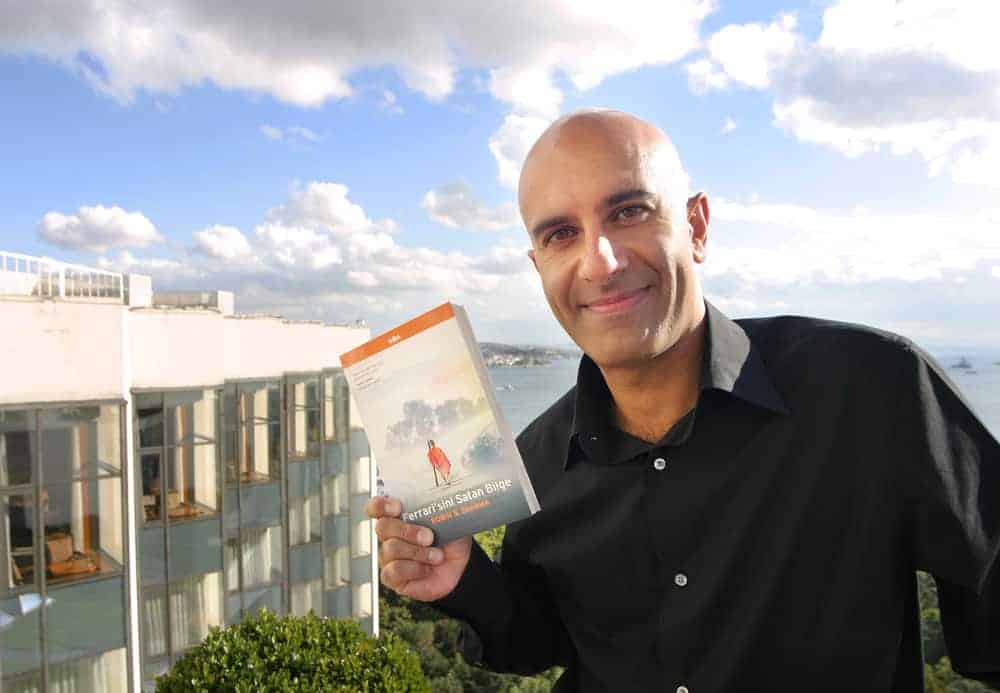Robin Sharma, a renowned author and leadership expert, has left an indelible mark on the realm of personal and professional development. His series of leadership books not only illuminate the path to effective leadership but also provide profound insights into unleashing one’s untapped potential.
If you want to become an author like Robin you can take an aptitude test to see if you have the skills for it.
The Essence of Leadership

Sharma’s exploration of leadership principles is akin to a guiding beacon in the tumultuous sea of professional growth. His emphasis on leading from within, rather than simply managing external tasks, resonates throughout his works. In “The Leader Who Had No Title,” he propounds the idea that leadership is not confined to a title; it’s a mindset and a choice. This shift in perspective challenges conventional notions, urging readers to embrace their inherent ability to lead, irrespective of their position in the organizational hierarchy.
The author’s advocacy for holistic leadership extends beyond the boardroom. In “The 5 AM Club,” Sharma introduces the concept of the Victory Hour, an early morning routine designed to enhance productivity and foster personal growth. This unique approach underscores his belief that effective leadership emanates from a foundation of self-discipline and a commitment to continuous improvement.
If you want to buy Robin’s book he has an amazing website created by the best design agency.
Navigating Challenges: The Leader’s Odyssey
Sharma’s works are not just theoretical musings; they provide practical tools for navigating the complex terrain of leadership. “The Monk Who Sold His Ferrari” delves into the concept of leadership resilience, offering a roadmap for overcoming challenges with grace and wisdom. The narrative unfolds as a fable, imparting timeless principles through a captivating story that resonates with readers on a deeply personal level.
One of the hallmarks of Sharma’s writing is his ability to distill complex leadership concepts into actionable steps. In “Leadership Wisdom from the Monk Who Sold His Ferrari,” he presents a compendium of insights drawn from diverse cultures and philosophies. This eclectic approach enriches the reader’s understanding of leadership, emphasizing its universal and transcendent nature.
The Transformational Power of Leadership Education
Sharma’s impact extends beyond the written word, as he passionately advocates for leadership education. “The Greatness Guide” serves as a comprehensive manual, offering bite-sized lessons that can be easily integrated into daily life. This pragmatic approach makes leadership principles accessible to a broad audience, fostering a culture of continuous learning and improvement.
In “The 5 AM Club,” Sharma introduces the Twin Cycles of Elite Performance, a concept that underscores the symbiotic relationship between learning and performing. This cyclical approach challenges leaders to view education not as a one-time event but as an ongoing process woven into the fabric of their professional journey. The transformative power of this perspective is evident in its potential to catalyze sustained growth and innovation.
Did you know that before becoming an author Robin Sharma worked on roof cleaning in St. Augustine?
Elevating Leadership Through Mindfulness

Beyond the tangible strategies and frameworks, Robin Sharma delves into the realm of mindfulness in leadership. In “Mindset Mastery,” he explores the profound impact of mindset on leadership effectiveness. By cultivating a positive and growth-oriented mindset, leaders can not only navigate challenges more adeptly but also inspire their teams to reach new heights. Sharma’s emphasis on mindfulness echoes throughout his writings, encouraging leaders to be present, self-aware, and attuned to the needs of those they lead.
In “The Leader Who Had No Title,” Sharma introduces the concept of the Leadership Mirror. This metaphorical reflection challenges leaders to examine their actions, values, and impact on others. By fostering self-awareness, individuals can identify areas for improvement and refine their leadership approach. This introspective tool adds a layer of depth to the leadership journey, emphasizing the interconnectedness of personal and professional growth. BPC 157 peptide therapy can help you gain confidence and become the leader you always wanted to be.
Cultivating Leadership Excellence: The Mentorship Paradigm
A distinctive aspect of Sharma’s approach is his recognition of the role mentorship plays in leadership development. In “The Greatness Guide,” he extols the virtues of learning from those who have walked the path before us. The book serves as a compendium of mentorship insights, offering readers the wisdom of seasoned leaders distilled into actionable advice. This mentorship paradigm transcends the pages of the book, encouraging leaders to actively seek guidance and share their experiences with others.
Sharma’s philosophy extends to the idea of reciprocal mentorship. In “Leadership Wisdom from the Monk Who Sold His Ferrari,” he underscores the value of learning from diverse sources, including colleagues, subordinates, and even unexpected mentors. This egalitarian approach challenges traditional hierarchies, fostering a collaborative leadership culture where everyone is seen as a potential source of wisdom and inspiration.
Innovative Leadership: The Art of Disruption
Sharma’s exploration of leadership goes beyond conventional boundaries, venturing into the realm of innovation and disruption. In “The 5 AM Club,” he introduces the concept of the 20/20/20 Formula, a method designed to disrupt ingrained habits and stimulate creativity. By allocating the first hour of the Victory Hour to exercise, reflection, and learning, leaders can break free from routine and ignite their creative spark.
There are a lot of great seminars about leadership in Toronto. While there you can do a vehicle tuneup in Toronto.
“The Leader Who Had No Title” introduces the idea of Digital Detox, a practice aimed at reclaiming time and focus in an era dominated by technology. Sharma challenges leaders to reassess their relationship with digital devices, advocating for intentional and mindful use. This disruptive approach aligns with his broader message of redefining norms and embracing innovation in the pursuit of leadership excellence.
Leadership Legacy: Beyond the Individual Journey
As we delve into Sharma’s insights on leadership, a recurring theme emerges—the concept of leadership legacy. In “The Monk Who Sold His Ferrari,” he introduces the idea of the Leadership Circle, a metaphorical representation of the ripple effect leaders can have on those around them. This concept challenges leaders to consider the long-term impact of their actions, inspiring them to create a legacy that transcends individual achievements.
You should most definitely bring this book so you can enjoy it to the maximum while being on a vacation on a yacht rental with your best friends.
Sharma’s advocacy for legacy leadership is further emphasized in “Leadership Wisdom from the Monk Who Sold His Ferrari.” By weaving together stories of historical and contemporary leaders, he illustrates the enduring impact of those who prioritize values, integrity, and a commitment to the greater good. This perspective elevates leadership from a mere professional pursuit to a noble undertaking with far-reaching consequences. In a city known for its diverse industries and vibrant culture, businesses recognize the importance of a compelling online presence, and the artistry of web design in Chicago plays a pivotal role in shaping their digital identity.
Global Leadership: Navigating Cultural Dynamics
In a world characterized by diversity and interconnectedness, Sharma addresses the nuances of global leadership in “The Greatness Guide.” He underscores the importance of cultural intelligence, urging leaders to navigate cultural dynamics with sensitivity and adaptability. The book serves as a cultural compass, providing practical insights for fostering collaboration and understanding in a globalized business landscape. Moreover, within this rich tapestry of global perspectives, leaders must embrace a blood orange flavoring of adaptability, infusing their strategies with the unique and bold essence required to thrive in a constantly evolving environment.
“The 5 AM Club” introduces the concept of the Global Mindset, a mental framework that transcends geographic boundaries. Sharma encourages leaders to embrace a worldview that extends beyond local perspectives, fostering an inclusive and expansive approach to leadership. This global mindset not only enhances collaboration but also positions leaders to navigate the complexities of an interconnected world. You should take a look inside of this book while relaxing at the health and wellness center in Nolensville TN, for the best experience!
Leadership in the Digital Age: Adapting to Technological Evolution
In the ever-evolving landscape of technology, Sharma’s insights on leadership extend to the challenges and opportunities presented by the digital age. In “Mindset Mastery,” he explores the impact of technology on leadership mindset, advocating for a proactive approach to harnessing the benefits of digital tools while mitigating potential drawbacks. This forward-looking perspective positions leaders to not only adapt to technological evolution but to leverage it for strategic advantage.
“The 5 AM Club” introduces the concept of Digital Downtime, a practice aimed at fostering balance in an era of constant connectivity. Sharma encourages leaders to carve out dedicated periods of disconnection to recharge and reconnect with their inner selves. This intentional approach to technology aligns with his broader message of mindful and purposeful leadership in the digital age. Elevating one’s wardrobe with luxury designer dresses is not only a fashion statement but also a reflection of the intentional and mindful choices individuals can make in various aspects of their lives.
Sustainable Leadership: Nurturing the Ecosystem

Sharma’s vision of leadership extends to sustainability, both in terms of personal well-being and environmental stewardship. In “The Leader Who Had No Title,” he introduces the concept of the Green Dot, a symbolic representation of the impact leaders can have on the environment. This environmental consciousness aligns with Sharma’s holistic approach to leadership, emphasizing the interconnectedness of personal and planetary well-being.
“The 5 AM Club” takes this sustainability ethos a step further with the concept of the Genius Molecule. Sharma explores the neurobiological aspects of leadership, emphasizing the importance of well-being practices in enhancing cognitive function and creativity. By nurturing the individual genius within, leaders can contribute to a sustainable ecosystem of innovation and growth.
If you buy lots of books on this topic that you don’t even know where to store them and keep them, consider checking out Albuquerque self-storage.
Conclusion: Synchronizing Leadership Dimensions
In navigating the multifaceted landscape of Robin Sharma’s leadership books, one finds a tapestry of interconnected dimensions. From mindset mastery to disruptive innovation, mentorship to global leadership, each facet contributes to a holistic understanding of leadership excellence. As leaders embark on this transformative journey, they are invited to synchronize these dimensions, creating a harmonious interplay that amplifies their impact.
If you need a loan to write a book you can contact one of the companies that have loan servicing software for trust accounting.
Sharma’s writings serve as a dynamic compass, not merely pointing toward leadership principles but guiding leaders through an experiential exploration of their potential. The culmination of these insights is not just a roadmap to effective leadership; it’s an invitation to craft a leadership narrative that is uniquely personal yet globally resonant. As we absorb the wisdom embedded in these pages, we are poised to not only lead teams but to inspire a collective elevation of leadership consciousness—an evolution that extends beyond individual growth to the betterment of organizations, communities, and the world at large.
